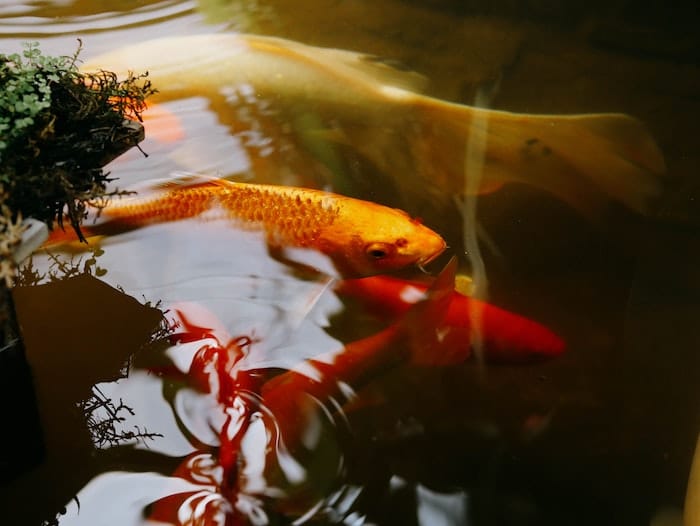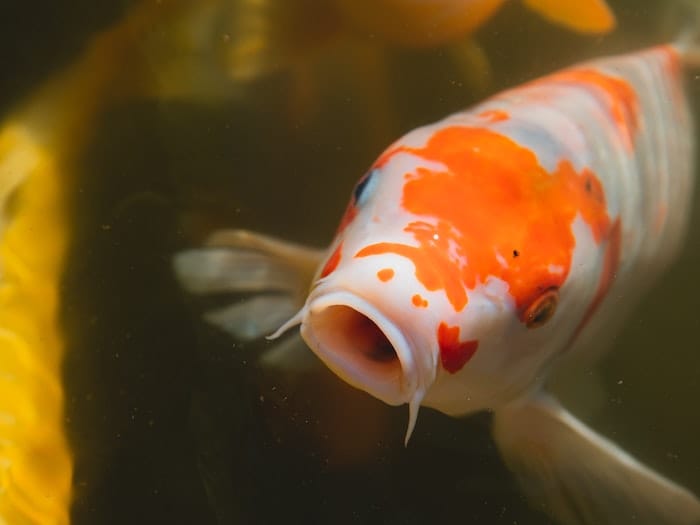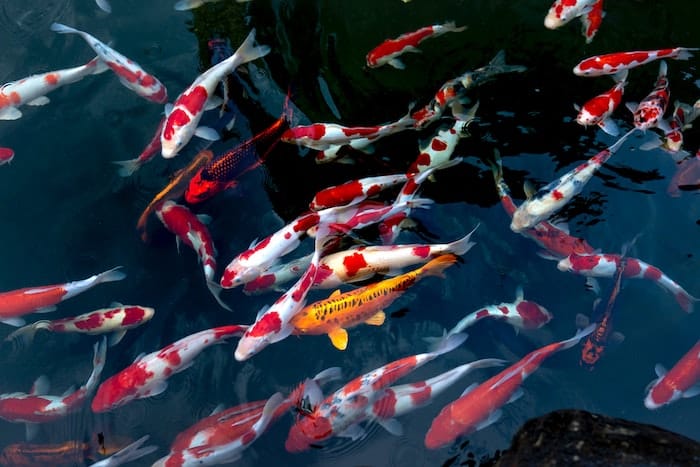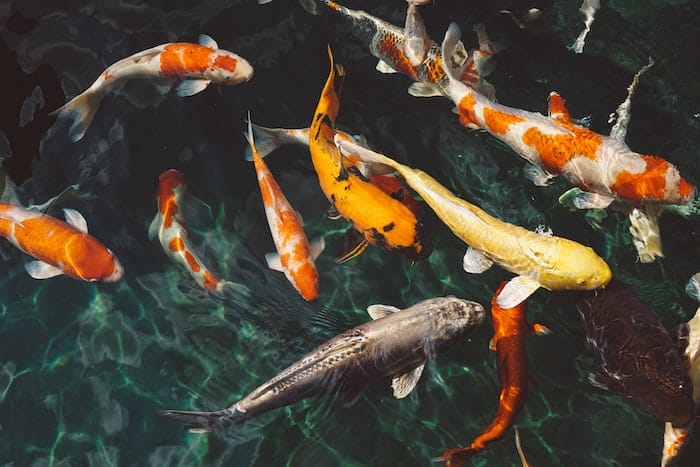Koi and goldfish are both members of the carp family (Cyprinidae), but they are two distinct species with some noticeable differences. These include:
- Body shape: Koi are generally larger and have a more streamlined body shape, while goldfish are shorter and rounder in shape.
- Fins: Koi have longer, flowing fins than goldfish, and their fins are generally more pointed. Goldfish have shorter, more rounded fins.
- Scales: Koi have larger, more prominent scales than goldfish, and their scales are usually more brightly colored.
- Coloration: While both koi and goldfish come in a wide range of colors, the coloration of koi tends to be more consistent and uniform across the body, while goldfish often have more varied and patterned coloration.
- Behavior: Koi are known for their active and sometimes playful behavior, while goldfish are generally more docile and relaxed.
- Habitat: Koi are typically kept in outdoor ponds, while goldfish can be kept in both indoor and outdoor aquariums and ponds.
Overall, while koi and goldfish share some similarities and are often kept together in the same ponds or aquariums, they are two distinct species with some noticeable differences in appearance and behavior.

Scientific Classification
The scientific name for goldfish is Carassius auratus and for koi it is Cyprinus carpio, which is the same as the scientific name for the common carp. Koi are a variety of the common carp that have been selectively bred for their unique coloration and patterns. Therefore, koi are a subspecies of the common carp (Cyprinus carpio koi), but they are often referred to simply as “koi” in the aquarium and pond-keeping hobby.
The scientific classification of a goldfish:
- Kingdom: Animalia
- Phylum: Chordata
- Class: Actinopterygii
- Order: Cypriniformes
- Family: Cyprinidae
- Genus: Carassius
- Species: Carassius auratus
The scientific classification of koi fish:
- Kingdom: Animalia
- Phylum: Chordata
- Class: Actinopterygii
- Order: Cypriniformes
- Family: Cyprinidae
- Genus: Cyprinus
- Species: Cyprinus carpio
Other Fish in the Cyprinidae Family
The Cyprinidae family, also known as the minnow family, is a very large and diverse family of freshwater fish that includes over 3,000 species. Some of the other fish that are in the Cyprinidae family include:
- Common carp (Cyprinus carpio)
- Tench (Tinca tinca)
- Bitterling (Rhodeus sericeus)
- Chub (Squalius cephalus)
- Dace (Leuciscus leuciscus)
- Barbel (Barbus barbus)
- Roach (Rutilus rutilus)
- Rudd (Scardinius erythrophthalmus)
- Ide (Leuciscus idus)
- Minnow (Phoxinus phoxinus)
These types of fish are found in a wide range of habitats, from fast-flowing rivers to still ponds and lakes, and come in a variety of sizes, shapes, and colors.

How Much Space Do Koi Fish Need Compared to Goldfish?
Both koi and goldfish are active and social fish that require adequate space to swim and thrive. However, because koi are generally larger and more active than goldfish, they require more space to live comfortably.
As a general rule of thumb, a koi pond or tank should provide at least 500 gallons of water per koi, with a minimum depth of 3 feet. This allows the koi to swim and exercise, and helps to maintain good water quality.
For goldfish, a minimum of 20-30 gallons of water per goldfish is recommended, depending on the size and number of fish. Goldfish also benefit from a minimum depth of 2-3 feet.
It’s important to note that these are just minimum recommendations, and providing more space is always better for the health and well-being of your fish. Additionally, the specific space requirements for koi and goldfish can vary depending on the size, breed, and number of fish, as well as the quality of water and filtration in the pond or tank.

Can Koi and Goldfish Live in the Same Pond?
Koi and goldfish can often live in the same pond together, as long as certain conditions are met. Both fish species are social and peaceful, and they can coexist in the same environment without too much trouble.
However, there are a few factors to consider when keeping koi and goldfish in the same pond:
- Koi are generally larger and more active than goldfish, so it’s important to make sure that the pond is large enough to accommodate both fish species comfortably. A good rule of thumb is to provide at least 500 gallons of water per koi, and 20-30 gallons of water per goldfish.
- Koi and goldfish have similar water quality requirements, but koi produce more waste than goldfish due to their larger size and higher metabolism. It’s important to make sure that the pond is properly filtered and well-aerated to maintain good water quality for both fish.
- Koi and goldfish have different dietary needs, so it’s important to feed them separately to ensure that they each get the right nutrition. Koi require a higher protein diet than goldfish, and they are also more likely to eat larger pieces of food.
- While koi and goldfish are generally compatible, there may be some territorial behavior or aggression if the pond is overcrowded or if there are limited hiding places. It’s important to monitor the behavior of the fish and make adjustments as necessary to ensure that everyone is getting along.
Will Koi eat a Goldfish?
While koi are known to eat smaller fish, they typically do not eat goldfish. In fact, many koi keepers keep koi and goldfish together in the same pond without any problems.
However, it’s important to note that individual fish can sometimes exhibit aggressive behavior, and koi may occasionally eat very small goldfish, especially if they are sick, injured, or weak. Additionally, if the pond is overcrowded or if there are not enough hiding places, the fish may become stressed and exhibit aggressive behavior towards each other.
To help prevent any potential issues, it’s important to provide a well-balanced diet for both fish and make sure that they each have enough space and hiding places in the pond. It’s also a good idea to monitor the behavior of the fish regularly and make adjustments as needed to ensure that everyone is getting along.

How Much Do Koi Cost Compared to Goldfish?
The cost of koi fish can vary widely depending on a number of factors, such as the size, age, quality, color, and pattern of the fish, as well as the region and market demand. On average, a small or young koi fish may cost anywhere from $10 to $50, while a larger or more high-quality koi can cost hundreds or even thousands of dollars.
Here are some general price ranges for different sizes of koi fish:
- Small or young koi (less than 6 inches) – $10 to $50
- Medium-sized koi (6-12 inches) – $50 to $200
- Large koi (12-18 inches) – $200 to $500
- Extra-large or high-quality koi (over 18 inches) – $500 to several thousand dollars
It’s important to note that the cost of koi can also vary depending on the seller and the location. Some specialty koi breeders or high-end koi retailers may charge more for their fish, while koi sold at pet stores or online may be less expensive. Additionally, koi fish that are bred for specific traits or patterns may also be more expensive.
The cost of a goldfish can vary depending on several factors, such as the breed, size, color, and quality of the fish, as well as the location and availability of the fish. On average, a common goldfish or a small fancy goldfish can cost anywhere from $1 to $5, while larger or higher-quality goldfish can cost $10 to $50 or more.
Here are some general price ranges for different types and sizes of goldfish:
- Common goldfish or small fancy goldfish – $1 to $5
- Medium-sized or larger fancy goldfish – $5 to $20
- High-quality fancy goldfish or rare breeds – $20 to $50 or more
It’s important to note that the cost of a goldfish can also vary depending on the source. Goldfish purchased from a reputable breeder or specialty store may be more expensive than those sold at pet stores or online. Additionally, certain breeds of goldfish, such as bubble-eye or celestial eye goldfish, may be more expensive due to their unique appearance and rarity.
Related Reading
Reviewed By: Tim Winter

Tim Winter has a strong affection for pets and wildlife. His years of experience caring for various types of pets has led him to share his knowledge with others on the best practices in pet care. Tim holds a Bachelor of Science from the University of Oregon School of Journalism and Communications.
